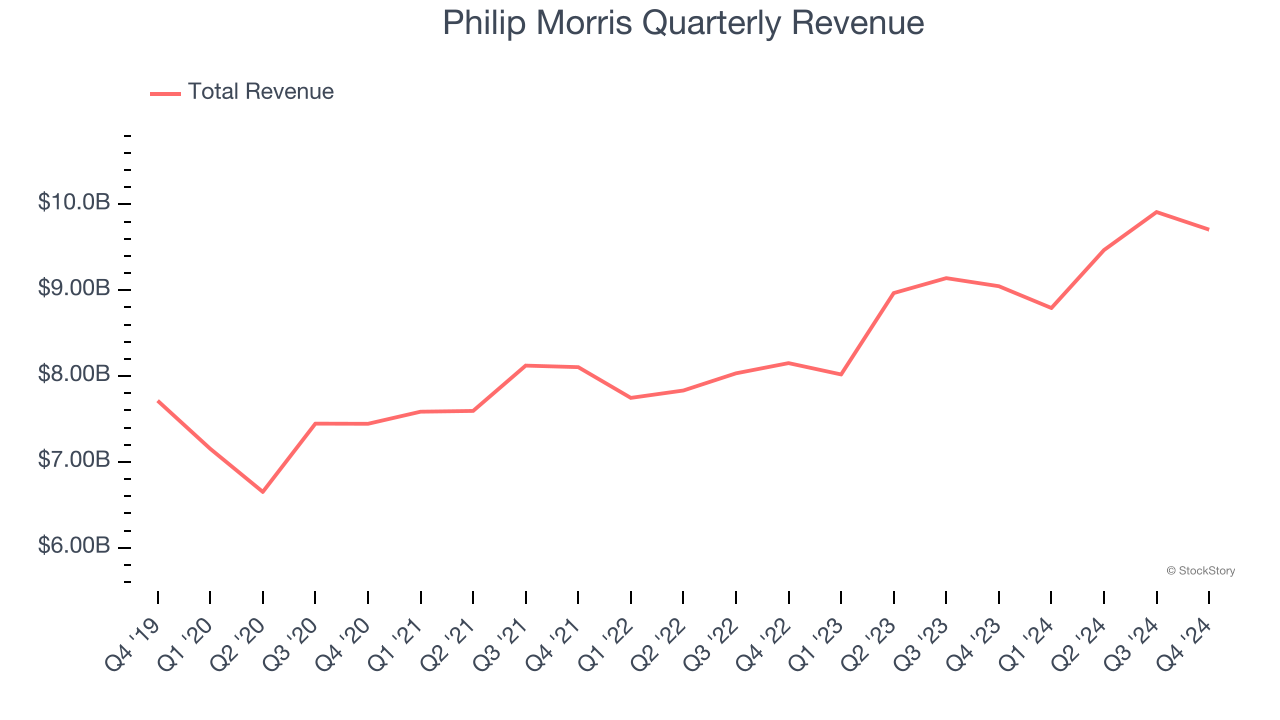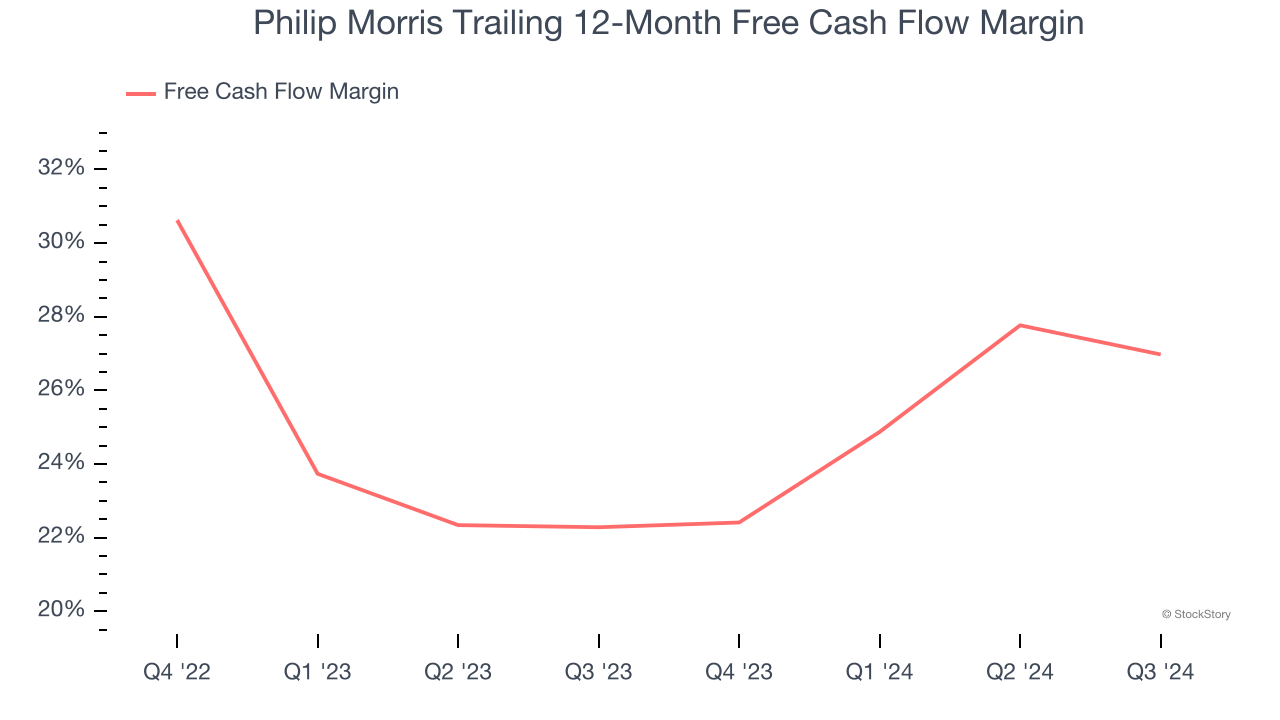
Tobacco company Philip Morris International (NYSE:PM) beat Wall Street’s revenue expectations in Q4 CY2024, with sales up 7.3% year on year to $9.71 billion. Its non-GAAP profit of $1.55 per share was 3.4% above analysts’ consensus estimates.
Is now the time to buy Philip Morris? Find out by accessing our full research report, it’s free.
Philip Morris (PM) Q4 CY2024 Highlights:
- Revenue: $9.71 billion vs analyst estimates of $9.44 billion (7.3% year-on-year growth, 2.8% beat)
- Unit sales of nicotine pouches like ZYN rose 46% year-on-year
- Adjusted EPS: $1.55 vs analyst estimates of $1.50 (3.4% beat)
- Adjusted EPS guidance for the upcoming financial year 2025 is $7.11 at the midpoint, beating analyst estimates by 1.5%
- Operating Margin: 33.6%, up from 31.9% in the same quarter last year
- Sales Volumes were up 2.3% year on year
- Market Capitalization: $203.7 billion
"2024 was a remarkable year for PMI. We delivered very strong full-year results driven by the continued growth of IQOS and ZYN in addition to a robust combustibles performance," said Jacek Olczak, Chief Executive Officer.
Company Overview
Founded in 1847, Philip Morris International (NYSE:PM) manufactures and sells a wide range of tobacco and nicotine-containing products, including cigarettes, heated tobacco products, and oral nicotine pouches.
Beverages, Alcohol, and Tobacco
These companies' performance is influenced by brand strength, marketing strategies, and shifts in consumer preferences. Changing consumption patterns are particularly relevant and can be seen in the rise of cannabis, craft beer, and vaping or the steady decline of soda and cigarettes. Companies that spend on innovation to meet consumers where they are with regards to trends can reap huge demand benefits while those who ignore trends can see stagnant volumes. Finally, with the advent of the social media, the cost of starting a brand from scratch is much lower, meaning that new entrants can chip away at the market shares of established players.
Sales Growth
Examining a company’s long-term performance can provide clues about its quality. Any business can put up a good quarter or two, but the best consistently grow over the long haul.
With $37.88 billion in revenue over the past 12 months, Philip Morris is one of the most widely recognized consumer staples companies. Its influence over consumers gives it negotiating leverage with distributors, enabling it to pick and choose where it sells its products (a luxury many don’t have). However, its scale is a double-edged sword because there are only so many big store chains to sell into, making it harder to find incremental growth. To accelerate sales, Philip Morris must lean into newer products.
As you can see below, Philip Morris’s sales grew at a mediocre 6.4% compounded annual growth rate over the last three years, but to its credit, consumers bought more of its products.

This quarter, Philip Morris reported year-on-year revenue growth of 7.3%, and its $9.71 billion of revenue exceeded Wall Street’s estimates by 2.8%.
Looking ahead, sell-side analysts expect revenue to grow 4.5% over the next 12 months, a slight deceleration versus the last three years. This projection doesn't excite us and indicates its products will face some demand challenges. At least the company is tracking well in other measures of financial health.
Here at StockStory, we certainly understand the potential of thematic investing. Diverse winners from Microsoft (MSFT) to Alphabet (GOOG), Coca-Cola (KO) to Monster Beverage (MNST) could all have been identified as promising growth stories with a megatrend driving the growth. So, in that spirit, we’ve identified a relatively under-the-radar profitable growth stock benefiting from the rise of AI, available to you FREE via this link.
Cash Is King
Although earnings are undoubtedly valuable for assessing company performance, we believe cash is king because you can’t use accounting profits to pay the bills.
Philip Morris has shown terrific cash profitability, driven by its lucrative business model that enables it to reinvest, return capital to investors, and stay ahead of the competition. The company’s free cash flow margin was among the best in the consumer staples sector, averaging 23.6% over the last two years.

Key Takeaways from Philip Morris’s Q4 Results
It was encouraging to see Philip Morris beat analysts’ revenue expectations this quarter, driven by its 9% sales growth in the Smoke-free division. Specifically, the division's growth was led by a 46% increase in unit sales of nicotine pouches like ZYN. We were also happy its gross margin, EPS, and EPS guidance were higher than Wall Street’s estimates. Overall, this quarter had some key positives. The stock traded up 7.7% to $141.10 immediately following the results.
Should you buy the stock or not? We think that the latest quarter is only one piece of the longer-term business quality puzzle. Quality, when combined with valuation, can help determine if the stock is a buy. We cover that in our actionable full research report which you can read here, it’s free.
